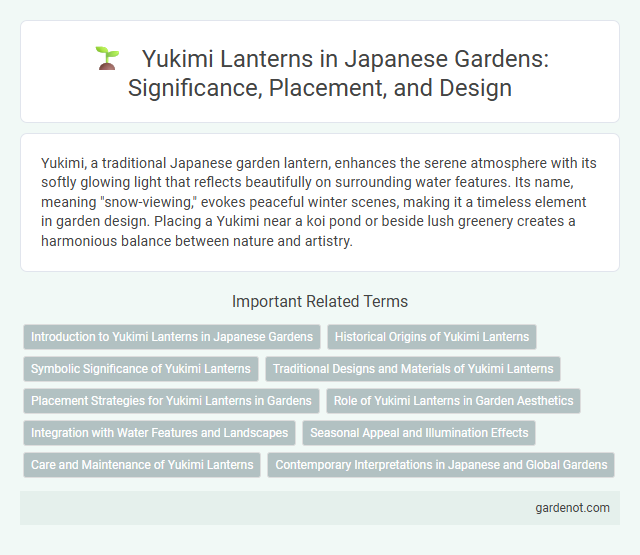Yukimi, a traditional Japanese garden lantern, enhances the serene atmosphere with its softly glowing light that reflects beautifully on surrounding water features. Its name, meaning "snow-viewing," evokes peaceful winter scenes, making it a timeless element in garden design. Placing a Yukimi near a koi pond or beside lush greenery creates a harmonious balance between nature and artistry.
Introduction to Yukimi Lanterns in Japanese Gardens
Yukimi lanterns, also known as "snow-viewing" lanterns, are traditional stone lanterns commonly found in Japanese gardens. Their distinctive wide umbrella-shaped tops are designed to catch snow, creating a serene, picturesque effect during winter months. These lanterns symbolize tranquility and are strategically placed near water features to enhance the garden's aesthetic and evoke a sense of harmony with nature.
Historical Origins of Yukimi Lanterns
Yukimi lanterns, also known as "snow-viewing" lanterns, originated during the Edo period in Japan, reflecting a blend of aesthetics and functionality in traditional Japanese gardens. These lanterns were designed with wide, spreading roofs to catch and hold snow, enhancing garden beauty during winter scenes. Their historical use underscores the Japanese cultural appreciation for seasonal changes and artistic garden elements.
Symbolic Significance of Yukimi Lanterns
Yukimi lanterns, also known as "snow-viewing lanterns," symbolize tranquility and the harmonious relationship between nature and human craftsmanship in Japanese gardens. Their wide, flat roofs are designed to catch snow, evoking the serene beauty of winter landscapes while illuminating pathways with a soft, ambient glow. These lanterns embody the cultural appreciation for seasonal changes and represent a bridge between light, shadow, and natural elements in traditional garden aesthetics.
Traditional Designs and Materials of Yukimi Lanterns
Yukimi lanterns, also known as "snow-viewing" lanterns, are traditional Japanese garden features characterized by their wide, flat roofs designed to catch and display snow. Crafted primarily from durable materials like granite and bronze, these lanterns embody timeless aesthetic principles rooted in simplicity and natural beauty. Their design integrates seamlessly with the surrounding landscape, enhancing the tranquil atmosphere of Japanese gardens through subtle illumination and elegant form.
Placement Strategies for Yukimi Lanterns in Gardens
Yukimi lanterns, traditionally placed near water features or low-lying garden spots, create reflections that enhance the serene ambiance of Japanese gardens. Positioning these lanterns on stable, slightly elevated ground prevents water damage while maximizing visual impact during twilight hours. Surrounding them with moss or low shrubs integrates the stone with nature, emphasizing wabi-sabi aesthetics and seasonal harmony.
Role of Yukimi Lanterns in Garden Aesthetics
Yukimi lanterns, often called "snow-viewing" lanterns, are iconic ornaments in traditional Japanese gardens, adding both illumination and artistic depth. Their wide, umbrella-like roofs create soft shadows and reflections on water surfaces, enhancing serene aesthetic experiences during evening hours. Positioned near ponds or pathways, Yukimi lanterns harmonize with natural elements, embodying wabi-sabi principles to elevate garden tranquility and visual balance.
Integration with Water Features and Landscapes
Yukimi lanterns are seamlessly integrated into Japanese garden water features and landscapes, enhancing their serene ambiance with soft, reflective illumination near ponds and streams. Positioned on low legs, these stone lanterns complement the natural flow of surrounding vegetation and water elements, creating harmonious visual balance. Their design emphasizes tranquility and connection to nature, making them essential in Japanese garden aesthetics.
Seasonal Appeal and Illumination Effects
Yukimi lanterns, known for their broad, umbrella-shaped roofs, enhance Japanese gardens by casting soft, diffused light that highlights seasonal changes in foliage and blossoms. Their design complements winter landscapes by allowing snow to rest gently on the roof, creating a picturesque contrast with the illuminated surroundings. In spring and autumn, the lanterns' warm glow accentuates vibrant colors, enriching the garden's aesthetic through carefully orchestrated illumination effects.
Care and Maintenance of Yukimi Lanterns
Yukimi lanterns require regular care to maintain their aesthetic appeal and structural integrity in Japanese gardens. Cleaning the stone surface with a soft brush and mild water solution helps prevent moss buildup and preserves the lantern's natural texture. Inspecting for cracks and ensuring proper placement away from excessive moisture prolongs the lantern's lifespan and enhances its role as a serene focal point.
Contemporary Interpretations in Japanese and Global Gardens
Yukimi lanterns, traditionally emblematic of Japanese garden aesthetics, have evolved within contemporary interpretations to blend classic design with modern materials and minimalist forms. These lanterns, known for their wide, overhanging roofs resembling a snow-viewing (yukimi) scene, are now incorporated into both Japanese and global gardens to evoke tranquility and seasonal harmony. Designers leverage Yukimi lanterns' symbolic resonance to enhance outdoor spaces with a fusion of cultural heritage and innovative landscaping practices.
Yukimi Infographic

 gardenot.com
gardenot.com